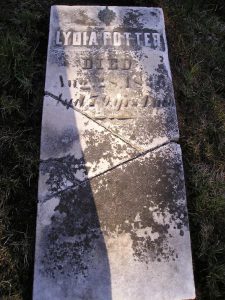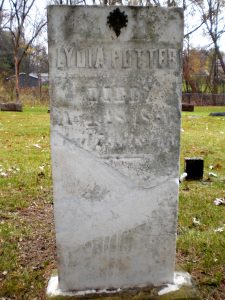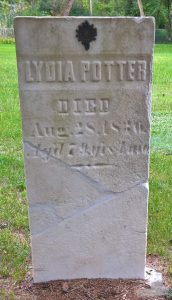Meet Lydia
Lydia's world
Lydia Barnes was born on 27 April 1757 probably in Farmington, now Bristol, CT. She died on 28 August 1836 and is buried in the Paint Creek Cemetery, Oakland Township, Oakland Co, MI. Her marriage to Lemuel Potter took place on 4 February 1779. Lemuel was born 15 Nov 1755, probably in Southington/Farmington, CT and died 26 Feb 1826 in Monroe Co, NY. Lemuel Potter became a freeman of the town of Southington in 1780. It is certainly possible that they were married in that location. One story to come down through the family was they had planned to marry after the war but instead took advantage of a one year of ration incentive offered to married men.
Lydia’s roots are deeply embedded in Connecticut history. The family were true pioneers and instrumental in the growth and development of the colony. Thomas, Lydia’s great-grandfather, was the first to arrive. He was a proprietor with three others, having been granted land in the “Poland” portion of Farmington CT in 1663. He served in the Pequot War and King Phillips War. His first wife, Mary, was indicted for witchcraft and put to death in 1662. Soon after, he married a second time to Mary Andrews. Lydia’s grandfather, Ebenezer, was born in 1675.
Ebenezer was considered the first permanent settler of Bristol, CT, impressively choosing to settle in the wilderness at over 50 years of age. He built his home on a well-traveled native trail, later a colonial highway, and was Bristol’s first tavern keeper. The Barnes family also built a sawmill and gristmill near the tavern. Two of his sons served on a committee to collect and transport provisions to Boston during the Revolutionary War.
Her father, David Barnes, born 17 April 1727 in Farmington, CT, was “of Bristol” when he wrote his will in 1795. His will was probated in Farmington, Hartford Co, CT. Called Captain, he too was an active member of the community, serving on a school committee and as collector of poll taxes.
Lydia would have been very aware of the fight for independence. George Washington used the route through Farmington and several thousand French troops encamped for a night in the area. Lemuel Potter, her husband, served in the 3rd CT Regiment, enlisting 22 February 1777 and discharged 19 February 1780. He took part in the Battle of Stoney Point. The family claimed he was rewarded for his service for that campaign, with one account stating it was a sword, and another a cane. Perhaps these, along with her family’s involvement, were the reasons she became involved in the cause.
Family lore, often repeated in the Potter family, made the claim: “Lydia Barnes, a young woman who was devoting her whole time and strength to the service of her country by making clothing for the soldiers at the front. She spun and wove the wool and cut and made the garments, learning the tailor’s trade that she might the more expeditiously supply the soldier’s needs. She worked so unremittingly at her task, standing continuously in a half bent position over her cutting table that she was never able to stand upright.” This description of what she was said to have done was included in an account of the time, “The careful matron has been accustomed to ‘seek wool and flax and work willingly with her hands; she layeth her hands to the spindle and her hands hold the distaff.”
DAR applications were initially submitted by Lydia’s great-granddaughter and great-great-granddaughter. Following the second submission, DAR determined that “future applicants must prove correct service” as Lydia’s service during the Revolutionary War was not supported by information independent of her family’s testimony. The search continues for proof of Lydia’s service to our country.
The migration of the couple included Paris, Herkimer Co, NY later known as Whitestown, Oneida Co, NY, Riga, Genesee Co, NY and Chili, Monroe Co, NY. The couple lived with their son Daniel. Lemuel died in Monroe Co, NY in 1826. After the death of her husband, Lydia went to live with her daughter Merilla Potter Hemingway in Oakland Co, MI making her a Michigan pioneer herself, having arrived before statehood. It is possible she came by the same route this daughter took coming with other settlers by ox team to Buffalo, NY, crossing Lake Erie by the boats that plied between Buffalo and Detroit.
Lydia is buried in the Paint Creek Cemetery, which was also known as the Baldwin Burial Ground. Hers is the oldest marker. In 1911 the General Richardson (now Stoney Creek) Chapter, NSDAR put a plaque/marker on her gravestone in honor of her work making uniforms during the Revolutionary War. In 2002 the Lydia Barnes Potter Chapter, NSDAR was organized in her honor. A Michigan Historical Marker, which included her story, was erected in 2006
Take a walk through the Paint Creek Cemetery, in Goodison, Oakland County, Michigan to see the quaint countryside cemetery. Images courtesy of Lydia Barnes Potter Chapter, NSDAR, members.
Restoring Lydia's Tombstone
Our members inquired about restoring and refurbishing Lydia’s tombstone. In 2017, it was lying on the ground, cracked in two parts. Watch the slide show to see the lifecycle of the restoration and refurbishment of Lydia’s tombstone. After the repair of Lydia’s tombstone, our chapter contributed toward restoration expenses.
Following the refurbishment, we went to the Paint Creek Cemetery and cleaned and scrubbed the tombstone.
- Tombstone was flat on the ground, cracked diagonally in two places.
- Top of the tombstone separated for restoration.
- Braced the back of the tombstone.
- Braced the front side of the tombstone.
- Fully upright and restoration complete.
- Our chapter cleaned the tombstone.
An Affidavit about Lydia Barnes Potter
There is an affidavit from Lydia and Lemuel Potter’s granddaughter, Abigail H. McArthur signed on August 19, 1911.
You can find all the details within the Michigan Historical Commission book, on page 456. She notes she heard the stories directly from her grandmother, Lydia Barnes Potter. Her grandfather was honored for the engagement known as the storming of Stony Point and by his bravery. He was awarded a cane by his major for meritorious conduct. Abigail H. McArthur had that cane in her possession at the time of this affidavit.
While Lemuel was defending our country, his wife Lydia was busy at home sewing uniforms or repairing uniforms both day and night for soldiers. She states of her grandmother Lydia “she spun and wove the wool and cut and made the garments, learning the tailor’s trade that she might expeditiously supply the soldiers needs. She worked so unremittingly at her task, standing continuously in a half bent half-bent position over her cutting table that she was never after able to stand upright.”
Finney, B. A. (1915) Michigan Historical Collections. Lansing, Michigan: Wynkoop Hallenbeck Crawford Co. State Printers.d



